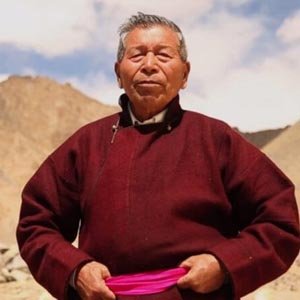This Ladakhi Man Keeps the Hills Alive By Building Artificial Glaciers
CHEWANG NORPHEL – A 83-year-old man who after completing his diploma degree in civil engineering from Lucknow, served 36 years of his life in government service as a civil engineer in Jammu & Kashmir before he took an early retirement due to his bad health and settled down in his hometown Ladakh. But his work for the society continued even after his retirement…
Superheroes do exist in real life, and the superhero about whom we are going to talk about does not have any superpower; on the other hand, he has super-skill, super-knowledge, super-understanding and super-erudition, by using which he saved the agriculture from getting vanished in the cold desert of India.
One freezing morning, Mr. Norphel was sitting outside his house when he observed that water running from the tap was turning into its solid form, as soon as it touches the ground and a pit of frigid frosty ice was formed.
“In Ladakh, the taps are usually kept open to keep the flow of water, so that the pipes can be prevented from bursting.”
This was when, Mr. Norphel realized and founded the solution to ease the water problem in Ladakh.
From last few decades, the influence of global warming has made the snowline gone up by 100m and more, from its previous level, due to which it becomes very difficult for farmers to irrigate their land in the beginning of spring season.
In Ladakh, ideal sowing period extends from April to May, but due to lack of water in the past, farmers were unable to moisten their land properly. And how can one, delay even a day in the sowing season. Moreover, glacier water comes down the hills in June, which is too late for farmers.
But Civil Engineer- Chewang Norphel, worked on this issue to mitigate the climatic conditions to give relief to the people of Ladakh region.
Burning his midnight oil, he planned everything and discussed it with some of the farmers of his region. Later he joined Leh Nutrition Project in 1994, the oldest NGO serving the inhabitants of Ladakh since 1978. And this is how his proposal came into action.
Chewang Norphel – “When I discussed my ideas with the farmers, some of them even laughed on it, but some of them thought of giving it a try.”
Till now, Mr. Norphel has built 10 glaciers, out of which the smallest one is 500 feet long in Umla region and the longest one is 2 km long in Phutse region of Ladakh.
Norphel’s artificial glacier is based on the simple principle of channelling the runoff water from the mountains to create artificial glaciers. In the hilly area, the inclination of the water stream is very steep, so the water in the stream does not freeze and is diverted to shadowy areas where sun rays do not fall directly. When the water reaches the storage site, then it is distributed in small quantity to reduce its speed and then it is stored in ice retaining walls in the form of frozen water.
Artificial glaciers are constructed closer to the villages so that the water can reach the fields quickly, as soon as the spring hits the Ladakh region. In this way, plenty of water for more than a month reach the field in the early spring and gives villagers a breath of comfort.
Water is a necessity which is needed by the birds in the air to the worms in the soil, and with the initiative of Chewang Norphel, investment of Rs. 90, 000 in building natural reservoirs is today providing water for the village of 700 people.
Today, in Ladakh, there are many roads, irrigation systems and other structures built by Norphel. For the people of Ladakh, he is a superhero.
Some of the titles and names by which he is called, in the honour of his work are – Climate Hero, Iceman, Man Who Creates Artificial Glaciers…
“There are many ways to conserve water, such as, by making dams, diversions, check dams, but artificial glaciers is a unique way … so they made me Ice Man – Chewang Norphel said smilingly”








